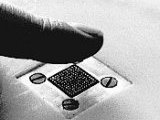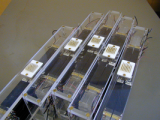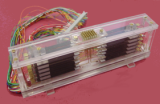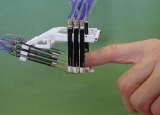
| Physics and Astronomy |
|
| Physics Home | Study here | Our Teaching | Our Research | Our Centres | News | Work here | EMPS |
|
Biomedical Physics
Research Projects
Facilities
|
|
Back to top
Physics of Human PerceptionRecent advances in functional brain imaging and the current interest in human-computer interactions have resulted in increased attention towards the study of perceptual processes. Projects in tactile perception are investigating strategies for the transmission of temporal, spatial and spatio-temporal information to subjects through specific sites on the skin by means of purpose-built stimulator hardware, including tactile arrays which deliver complex stimuli to the fingertip via a close-packed set of vibratory transducers, producing virtual touch sensations that mimic "natural" touch. Spatial distribution of touch stimulation is important in relation to texture representation and in relation to defining the edges and corners of objects. Applications of this work include sensory substitution for the hearing impaired and virtual environments, where it is now feasible to add touch information to enhance an environment created with visual and auditory signals. The group is at the forefront of research in tactile displays for HCI, and has recently been a partner in the European Network of Excellence ENACTIVE and the virtual textiles project HAPTEX(IST-6549). Touch receptors in the skinThe skin contains various populations of touch receptors: pacinian receptors and three types of non-pacinian receptor. These differ in terms of their frequency response, and in order to evoke a wide range of "realistic" touch sensations an array must operate over a significant fraction of the tactile frequency range of, say, 10 to 500 Hz. Vibratory stimulation in the upper part of this frequency range (approximately 100 - 500 Hz) is expected to stimulate pacinian receptors predominantly. Stimulation at lower frequencies is expected to stimulate non-pacinian receptors predominantly. We have recently undertaken a study of the location and sensitivity of pacinian corpuscles. The Exeter fingertip stimulator arrays for virtual touch



In "natural" touch perception, sensations are produced by spatiotemporal patterns of mechanical disturbance at the skin surface. The Exeter arrays are designed to simulate such sensations on the fingertip by artificially generating the appropriate patterns of tactile stimulation. The spatial resolution required for stimuli is determined by the density of touch receptors in the skin - around 1 mm² on the fingertip. Our first tactile array (top left image) was designed as a psychophysics tool and constructed with 100 contactor pins arranged on a 1 mm × 1 mm square matrix over an area of 1 cm² which covers the fingertip. Each contactor is driven by a piezoelectric actuator - the 100 drive waveforms can be individually specified in software and are delivered via a purpose-built interface. We have also constructed a variety of similar devices (see other images) for applications involving active exploration of virtual tactile environments:
fMRIUsing the technique of functional magnetic-resonance imaging (fMRI) it is possible to visualise those areas of the brain which are activated in touch perception. We are investigating cortical changes involved with Tactile Movement and Complex Regional Pain Syndrome. |
